 |
| The Incantation of Frida Kahlo - Version One |
 |
| The Incantation of Frida Kahlo - Version Two |
 |
| The Incantation of Frida Kahlo - Version Three |
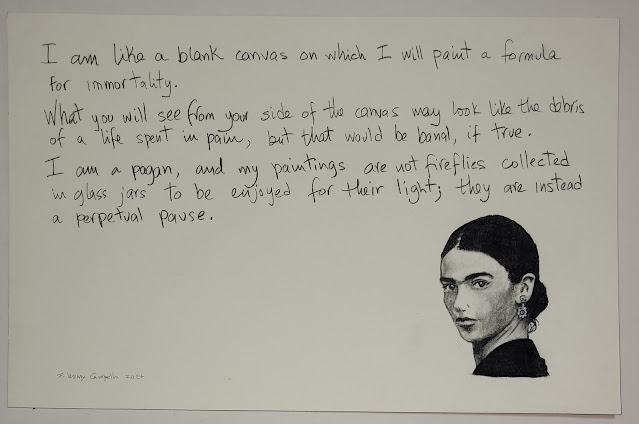 |
| The Incantation of Frida Kahlo - Version Four |
Since 2003... the 11th highest ranked art blog on the planet! And with over SEVEN million visitors, F. Lennox Campello's art news, information, gallery openings, commentary, criticism, happenings, opportunities, and everything associated with the global visual arts scene with a special focus on the Greater Washington, DC area.
 |
| The Incantation of Frida Kahlo - Version One |
 |
| The Incantation of Frida Kahlo - Version Two |
 |
| The Incantation of Frida Kahlo - Version Three |
 |
| The Incantation of Frida Kahlo - Version Four |
I fondly recall when the Canal Square complex in Georgetown at 1054 31st Street, NW off M street and 31st was home to SEVEN independently owned commercial fine art galleries!
Ready for some GREAT news?
There's new blood trying to re-start the DC gallery art scene there! From GeorgetownDC.com:
Cabada Contemporary (1054 31st St NW, #9) on March 21 from 6:30 pm – 8:30 pm at the opening reception for BLOOM – an exhibition co-hosted by the neighboring gallery ArtRobin (1054 31st St NW, #6). Enjoy drinks, light refreshments and conversation with other art enthusiasts. The exhibition features works by acclaimed abstract expressionist artist Javier Cabada and his daughter, figurative artist and gallery owner Sabrina Cabada. The two have not exhibited together in over two decades. Cabada Contemporary will exhibit works by Javier and Sabrina, along with a curated selection of established and emerging local artists. Cabada Contemporary and ArtRobin have united to the form the Galleries at Canal Square and will co-host monthly exhibitions.
 |
| BLOOM Opening at Cabada Contemporary |
GALLERY RECEPTION: It is our pleasure to invite you to our first opening reception. Join us for an art-filled evening as we celebrate the unveiling of Cabada Contemporary and the reawakening of the coming season. BLOOM: A Revival Celebration of Art showcases the vibrant colors of spring. Featuring works by Javier Cabada, Sabrina Cabada and Edward Alan Gross.
Opening Reception:
CABADA CONTEMPORARY 1054 31st Street, NW # 9 Washington, DC 20007
Thursday, March 21st, 2024 6:30 pm - 8:30 pm
Yesterday I reported for duty at ARTOMATIC, which had been given permission by the City Kommissars to re-open at 6PM. Lots of hard-working people behind the scenes deserve a great THANK YOU!
Cute lady named Kira was on duty greeting all the voluntolds for the 3:30 - 8:30PM Friday shift: Maria, Laila, Martinez, Laurel, Danielle and many others. I lucked out and got floor walker/docent duties on the 8th floor with the nice lady Laila, whom I soon bored with my tales of how nice my cousin's wife Fariba is...
The 8th floor at Artomatic is magical becuse it is wide open, so people can flow from artist to artist without room-gallery feeling of some of the other floors.
 |
| 8th floor view at Artomatic 2024 |
 |
| Sondra Arkins' Bamboo Showers at Artomatic 2024 - Listen to them below |
There are a lot of graffiti artists at Artomatic (as usual), and Luis Rosenfeld stood out to me as one of the better ones whom I've seen over the years! The carefully installed and orchestrated space on the 8th floor testifies to that!
 |
| Luis Rosenfeld at Artomatic 2024 |
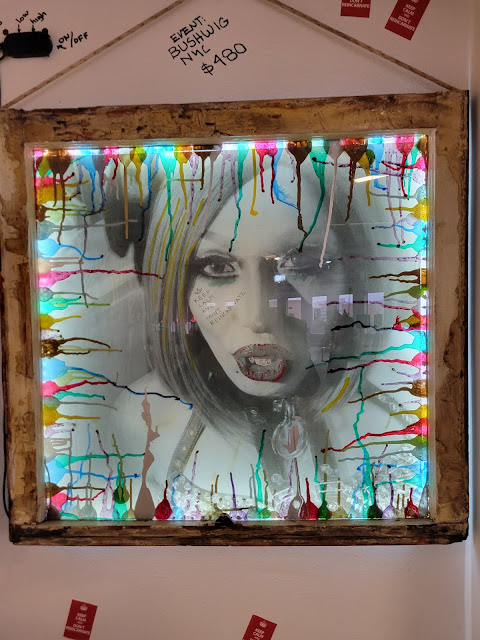 |
| Luis Rosenfeld at Artomatic 2024 |
 | ||
| Pink Compass, True North - by Sarah Jane Rodman at ARTOMATIC 2024 |
 |
| Anthony D'Amico at Artomatic 2024 |
 |
| Marcos Smyth - Best Ever Driftwood Sculpture Award at ARTOMATIC 2024 |
 |
| Mural by Jeff Huntington at ARTOMATIC 2024 |
 |
| Dorothy Hickson sculpture at ARTOMATIC 2024 |
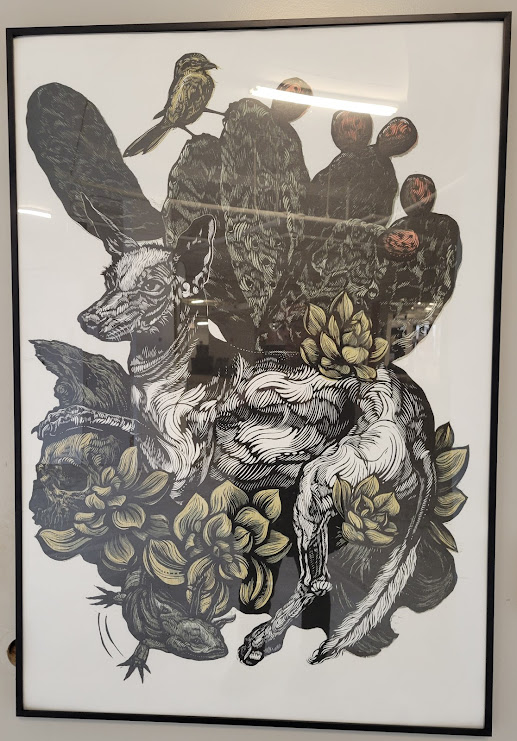 |
| "El Guardian" (The Guardian) by Daniel Hernandez at Artomatic 2024 |
 |
| "Hasta la victoria siempre" at AOM 2024 in Mexican Pavilion |
 |
| Drawing by Daniel Madruga |
 |
| Drawing by Daniel Madruga |
From the art school files: "Homage to Carmen Herrera", c. 1979 and done at Printmaking class at the University of Washington of Art in Seattle. It's a viscosity monoprint... I am pretty sure that at the time I was the only person at the school who knew who Carmen Herrera was, maybe in the entire state of Washington!
 |
| HOMAGE TO CARMEN HERRERA 1979 viscosity print by Florencio Lennox Campello |
Michael Janis knows why!
Artomatic, the renowned art show that just opened in the Nation's Capital boasting a kaleidoscope of creativity, abruptly shuttered its doors, leaving attendees puzzled and artists outraged. But what if there was more to this closure than met the eye?
Rumor has it that hidden within the vibrant tapestry of Artomatic lies a secret society known as the Chromatic Illuminati. This clandestine group believes that colors hold immense power over human perception and emotion, capable of influencing society on a grand scale. As artists gathered to showcase their works, the Chromatic Illuminati saw an opportunity to manipulate these forces for their own enigmatic agenda.
According to whispers in the DMV underground art scene, certain pieces featured at Artomatic unknowingly tapped into ancient color codes, revealing truths about the world that the Chromatic Illuminati deemed too dangerous to be exposed. Sensing a threat to their clandestine operations, the society swiftly moved to shut down the event, citing vague "security concerns" to mask their true intentions.
But what were these forbidden truths hidden within the hues of Artomatic? Some speculate that certain artworks contained subliminal messages, unlocking hidden knowledge about government cover-ups or cosmic mysteries. Others believe that certain color combinations emitted frequencies capable of altering consciousness or even bending reality itself.
As conspiracy theorists delve deeper into the mystery, they uncover a web of intrigue connecting influential figures in politics, art, and academia. Could it be that the closure of Artomatic was just the beginning of a larger scheme orchestrated by the Chromatic Illuminati to control the very fabric of reality through the manipulation of color?
Bwah ah ah!!!
The deadline is this Friday for the 37th Annual Northern National Art Competition in Nicolet College in Rhinelander, Wisconsin! It has my highest possible recommendation for a juried Art Competition! Details here.
More than $8,500 in prize money will be awarded, including three $1,000 Awards of Excellence!
Patricia de Poel Wilberg not only has one of my fave artists' names on the the planet, but the lady is another of the great glass masters of the DMV, which seems to be one the planetarian epicenters for unique takes on creating art with glass.
She's in room 5006 at Artomatic on the 5th floor, and her unique visual take on the subject matter, which she then presents using glass as a substrate is unique and refreshing, and like me, clearly the lady loves to tell nuanced stories.
 |
| La Licorne by Patricia de Poel Wilberg at room 5006 in Artomatic 2024 |
Sold at ARTOMATIC on opening night! Guy sees it, texts it to his cousin in Miami, Florida, cousin calls me, we close the deal and now will head to Miami as soon as AOM closes! Done in 1977 and sold almost 50 years later!
 |
| ISLA BALSERA from the Cuba Series - 1977 by Florencio Lennox Campello |
Attended AOM's opening night last night - I arrived a bit early in order to walk the 5th floor and begin the process of awarding my usual Artomatic awards and eventually pick my top 10 AOM artists.
 |
| Melissa Burley in room 5103 at Artomatic 2024 |
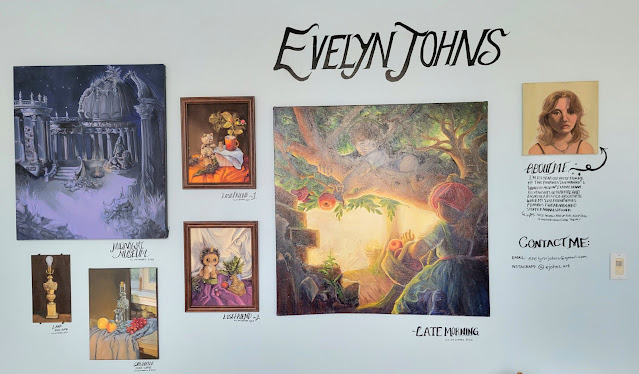 |
| Evelyn Johns in Room 5045 at Artomatic 2024 |
 |
| Lila from the SCAR series by Rahul Shah at Artomatic |
 |
| Lucky Art Studio in room 5090 at Artomatic 2024 |
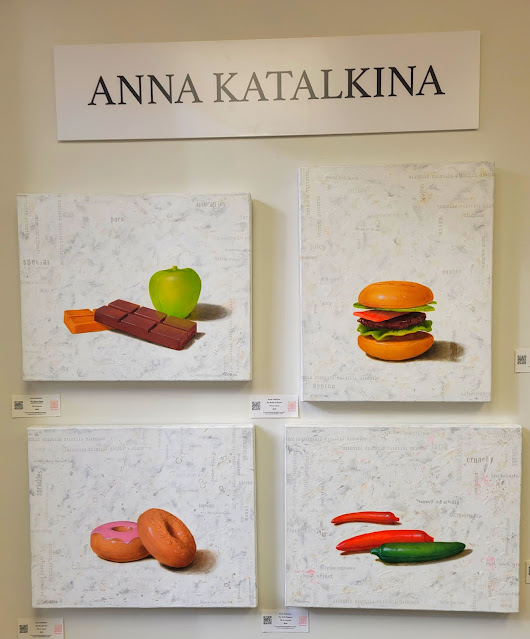 |
| Anna Katalkina in room 5087 at Artomatic 2024 |
 |
| Joseph Shepperd Rogers in Room 5091 at Artomatic 2024 |
 |
| Phyllis Mayes in room 5063 |
 |
| J.L. Hussey - Musicians series in room 5014 |
 |
| Little Walter by J.L. Hussey from the Musicians series in room 5014 |
 |
| Young & Frida V by Ric Garcia in room 5033 |
 |
| Beaker artwork by Jenn Bock in room 5073 at ARTOMATIC 2024 |
 |
| Andrew Wodzianski in room 5061. |
 |
| J. Jordan Bruns mixed media work at Artomatic 2024 |
Best Frida Kahlo (2D) in a floor with lots of Frida Kahlos will be a really tough category when I explore all floors and give the final award in a few days
On just the 5th floor there are a LOT of art pieces about the Fridanator, including a really good one from a Lebanese artist.
But what really stood out to me was this work by fellow Cuban-American artist Ric Garcia.
And at $75 Samolians, this is clearly one of the best - if not the best! - deal at Artomatic! Buy them now!
Quentin Tarantino: A Graphic Biography is without a doubt a really good primer for those who are novices to the Tarantinean Empire as well as those, who like me, cannot resist watching Pulp Fiction for the 20th time when we come across it the tube while channel surfing.
The graphic bio spends time discussing QT's youth, including the part played in his upbringing by his supermom Connie, who as a single mother raised Tarantino while busting her ass initially as a nurse in California.
Tarantino's "training" as nearly everyone who is a QT fan knows, came from his experience working in a video rental store (remember those?)... if my memory serves me right, one of his best buds from those days was the really super-good artist Steve Martinez, whose work often appears in Tarantino's movies and whose work was exhibited in DC in the 1990s at either the Fraser Gallery or eklektikos - my memory fails me. The painting of Uma Thurman in Pulp Fiction is in fact by Steve.
I remember him and I once discussing the huge size of Thurman's hands, which in the painting look out of proportion, until you fixate on them in any of her movies and notice that the lady has some fucking giant paws!
Back to the book... the press release summarizes it by noting that:
From the set of 1993’s Pulp Fiction, to a bar room meeting with Robert Rodriguez and an inspirational lunch with Leonardo di Caprio, this unique graphic novel takes us across a series of Hollywood-inspired vignettes covering the movie-obsessed life and career of one of modern cinema’s greatest filmmakers – Quentin Tarantino.
It is those meetings that essentially tell most of the story, and it really delivers in a fresh, novel way, as it places the reader next to Uma when she discusses ideas with the man!
Here's one of the panels (note the size of Ms. Thurman's hands... cough, cough...).Artomatic, as I once noted on the Kojo Nmandi show, is the visual arts extravaganza that everyone loves, but art critics hate.
Why do they hate AOM? In 2009 I explained it thus, referencing the 2009 AOM version:Criticism, Journalism ethics and AOM
I've been reviewing art shows since the beginning of the 80s decade during the last century, when I started doing so as an art student at the University of Washington School of Art.
Since then I have moved at least 25 times, lived twice in California, twice in Rhode Island, twice in Europe and twice in the Greater Washington, DC area, to highlight a few of those moves. And throughout all those years I have been involved in the arts, usually as an artist, quite often as a dealer, but always as a writer.
And as part of those experiences I have met dozens and dozens of art critics and writers who write about art, and using those experiences I feel that I can form a pretty decent and sound opinion about what I will discuss next.
Most writers who write about contemporary art shows start by physically visiting the gallery, or museum, or space where the show is being held, in order to look at the artwork (I say most because I know of at least two well-known writers, one a critic for a major newspaper and one a well-known blogger, who wrote reviews as if they'd been to the shows, but it was later proven that they had never visited the space nor seen the show).
Is it the case that some reviews are being written after simply viewing an art show online? Probably, but let's say that generally speaking, most art writers and art critics (there's a difference by the way), start by visiting the space where the show is being held.
If they are lucky enough to write for a publication which pays them to review shows, they either get a flat, per review payment, or a per-word payment (usually also associated with a maximum number of words limit). Some also write the reviews for free, just to be published.
So a typical writer either (maybe even and/or):
(a) Get's a flat payment for a review - let's say $500 in our forthcoming example
(b) Get's a per word payment for a review - Let's say $1 per word with a limit of 600 words
(c) Does it for free
So let's say Billy Artsy writes for a publication which uses either (a) or (b) above, and usually Billy goes to a gallery to see a show that interests him, or is assigned to cover a new museum show. It's a little different in either case (museums usually have press previews with all kinds of packages and hand-outs and discussions and opportunities to meet the curators and/or artists and ask questions.
But in the case of galleries, Billy either drives to the gallery, or takes the subway or bikes to the gallery, arrives and enters the space. In the Greater DC area, your average gallery's group show probably has 30-35 works of art hanging by maybe 15-20 artists. Some juried competitions may have as many of 50 artists. The largest (non AOM) group show that I can recall in our region was "Seven," which I curated a few years ago for the WPA and which had 66 artists in the seven galleries of the Warehouse spaces on 7th Street. There were around 200 works of art in that show, as well as a couple of installations and several performances.
But your average gallery group show that Billy is used to seeing and reviewing, and getting paid for is about 30-35 pieces of art by a dozen or so artists. That is his average reference point for a group show.
Once he arrives at the gallery, the owner or attendant recognizes Billy, gets up and greets him (heaven forbid that Billy is not recognized and treated a little special by the dealer). Depending on several variables, Billy can either be aloof or very friendly to the dealer.
Some art writers see art dealers as the "enemy," while others are mature and understand that just like the writers, the dealer is a key part of the art world universe.
Billy then spends about 15 or 20 minutes looking at the artwork, reading any press materials that he may have been handed, and taking notes on his forming opinions on the show. He may ask a question or two, or simply ignore everyone and focus all his attention on the art at hand. If Billy is especially tuned to a show, he may spend longer there, but let's say that all the artists are new to Billy and after 15 minutes he leaves.
Let's do a little Math and let's keep the numbers simple for simplicity sake. We're accelerating Billy a bit (in my own experience as a gallerist, our DC area critics hang around closer to 30 minutes per visit), but he takes 15 minutes to look at 30 works of art; this equals 30 seconds per work of art.
Later Billy submits the review, and a couple of weeks later he gets a check for $500.
A few weeks later Billy's editor emails Billy and asks Billy to do a review on Artomatic, as the editor keeps hearing about this "Artomatic thing" and getting dozens of letters (cleverly being written to the editor by the Artomatic artists) asking why the editor's newspaper hasn't covered Artomatic.
Billy takes the subway to go see AOM, as he has never really driven around SE and the AOM website tells him that the event is located in a building right on top of a subway exit.
When Billy arrives he is greeted by two volunteers who hand him material on AOM, and neither of the volunteers recognize Billy, nor he them. He asks on which floor the show is, and the volunteers suggest that Billy start on the 9th floor and work his way down. Billy finds it hard to believe that there are nine floors of art.
Billy takes the elevator to the 9th floor and comes out to face yet another volunteer sitting on a desk by the elevators. The volunteer smiles at Billy, but does not recognize him.
Billy begins walking the 9th floor. Already, on this floor alone, is the biggest group show that Billy has ever been to; it hasn't hit Billy yet, but soon he'll realize that there are eight more floors to go.
Billy is a little overwhelmed from the very beginning, and because of the large number of artwork and artists, he comes across a lot of what he considers really bad art: lots of tasteless nudies, loads of unsophisticated beginner art, terrible portraiture including more boudoir portraits in one place that Billy has ever seen in his life.
Billy is seeing a lot of the type and level of artwork which Billy has never seen and most probably would never see in the galleries that Billy tends to favor.
Because of the way the artists' booth are, Billy started (pre-conditioned from his many gallery visits) by weaving a sine wave walking pattern around the gallery walls and working his way around the floor and looking at each artist's gallery individually.
An hour later Billy realizes that he's not even three quarters of the way through the 9th floor and he still has 8 more floors to go.
And so Billy begins to (as humans do) adapt to the sheer size of the art show in front of him, and begins to speed up a little. He no longer visits each artist's gallery wall, but walks at a fast clip between the walls and glancing from the middle left and right covering 8-10 artists at a glance and only pausing to look at the work a little closer if something catches his eye from afar.
He begins to miss details and also misses entire groups of artists. When he walks by the Barbies, he doesn't realize that there are multiple artists in that set of Barbie artwork. He also misses the nuances of David D'Orio's wonderfully minimalist glass sculptures of recycled materials. As he makes the turn into a new aisle, his speeded up sightseeing is directed to one side at that moment and he completely misses Rania Hassan's deceptively complex marriage of painting with 3D sculpture.
By the time Billy finishes the 9th floor, he's sure of four things:
(a) no way that he can cover nine floors of art in this one visit unless he speeds up considerably.
(b) most of the work in the show is dreck.
(c) his notes are all from the first hour on the floor
(d) None of these artists are really good enough to show in a gallery and that's why they are here.
He walks down to the 8th floor, where the AOM floor attendant smiles at him, but once again does not recognize Billy.
He is now in full speed mode; if the artist's work doesn't grab Billy from ten feet away, forget it. At this point all that Billy is seeing are robots, skulls and a lot of bad photos of nude women, plus an annoying huge number of bad portrait artists. he is also missing a lot of intelligent, good art, a lot of it.
And then Billy is recognized by an AOM artist, and to Billy's dismay the artist wants to make sure that Billy sees his work. Billy promises to swing by, but in a nice way tells the artist that he is busy and needs to move on.
There's a small crowd of people in front of Deb Jansen's amazing revenge installation on this floor, and Billy, attracted by the crowd, slows down to see what the fuss is all about. He is hypnotized by what Jansen has done and Billy makes some notes about this installation. It's the first time that he has stopped to actually look at work closely on the 8th floor. Had not there been a crowd in front of Jansen's installation, Billy would have missed it as well.
Fifteen minutes later Billy has finished his whirlwind walk through of the 8th floor. It still took him half an hour, and in that 30 minutes he has "reviewed" about 100 artists and about 2500 works of art. He has completely missed the work of nearly a dozen artists on this floor who are already in the collection of major museums and represented by galleries all over the US and Europe. Blue chip artists in a plebian art show.
He also misses several "new" artists who will soon move on to galleries, museums and other such high art places.
By this time Billy's mind is made up. Nothing in the remaining seven floors can save AOM from the wrath of Billy's review.
He debates if it is even worth it for him to look at the rest of the show, but Billy's ethical side wins out and he descends to the 7th floor, where he is greeted by yet another floor attendant who doesn't know Billy from her aunt Elvira.
Billy finishes the 7th floor in 15 minutes, a new floor record. He only stops to glance at the glass displays by the British Sunderland artists because the displays caught his eyes as very "gallery like." The professional-looking displays put Billy in his comfort zone.
But he has already been at AOM for over two hours and has only seen three floors.
He debates skipping the six other floors, and "just to be fair," decides to pick one more floor at random, to "see if anything is different."
He decides on the 5th floor. By now it's getting a little into the evening and Billy is surprised at to how many people are viewing the show. Billy has never seen more than a couple dozen people in an art show at any time in any gallery, and even on the rare openings that he goes to, not more that 30-40 people in at once.
At AOM Billy sees hundreds and hundreds of people pouring in, and the elevators are getting crowded and slow and a tired Billy has to wait for an elevator to take him down.
On the ride down Billy decides on the 3rd floor and gets out. He sort of glances around and tries to absorb the entire floor from the edge of the elevators' entry points.
Billy decides to pack it and go home to write his review of Artomatic. He has seen more artwork in the last three hours that he has all year round. Most of it quite forgettable to Billy, atrocious even. In the process he has also missed seeing more artwork than most critics see in a year. And his visually overloaded mind has not seen the truly outstanding work of dozens and dozens of new and established good artists.
But Billy will write a review about the entire show, including the 700 plus artists whose work Billy never saw. Had Billy known about the scope of this huge show, Billy would have studied the artists' list ahead of time and highlighted the well-known artists whom Billy has already reviewed in the past, when they showed in the galleries that Billy frequents. That way Billy covers his own review foot prints.
But Billy missed them, and he's about to carpet bomb the entire show, including artists who Billy actually likes and whose gallery shows he has reviewed in a positive light.
Billy goes home and he is tired. Because it is now rush hour the subways are crowded and by the time Billy gets home, he is exhausted, both physically and mentally overloaded.
A couple of glasses of wine from a wine box helps Billy to relax a little as he sits in front of his laptop and Googles the web to see what other critics have written about AOM. After all, Billy wants to ensure that he is aligned with his elder critics and with the faddish new ones from the art blogs.
Almost to a man (woman) they all write bad things about AOM's artwork. What Billy doesn't realize is that many of them saw AOM in the same manner that Billy did. Some of them have never even visited AOM, but they still trashed it.
Billy revs up his trendy Mac and begins to earn his $500, which is what he would have been paid if he just went and had reviewed a "regular" gallery show, with maybe one artist's solo or a dozen artists' group show.
Billy trashes AOM, lest he be ever asked to do that much work again.
When the review is published, Billy's editor is surprised by the large outpouring of hate letters and emails and comments about the review. They come mostly from AOM artists, disgusted with Billy's review of the show. But they are unaware that they're about to help with Billy's career at the paper.
Billy's editor is pleased to discover that Billy has so many readers; after all, a letter is a letter, and Billy's AOM review column has received more letters and comments than all of Billy's previous columns added together.
This becomes a good checkmark on Billy's record with his editor. Who knew that Billy's gallery review column had some many followers?
Billy is pleasantly surprised by the positive outcome of an otherwise exhausting event.
Sometimes it bothers Billy to recall that he never really saw all the work in the manner that it deserved, but he does a little Math and he feels better when he discovers that in order to review AOM in the way that he reviews all other art shows, he would have had to spend a dozen hours there just to give each artist about 3/4 of a minute. That's an impossible task, if you ask Billy, especially for a measly $500 bucks.
That makes Billy sleep better at night and feel like he's still an ethical writer.